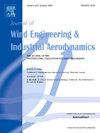低坡山墙屋顶上光伏板的风致荷载:板尺寸效应
IF 4.9
2区 工程技术
Q1 ENGINEERING, CIVIL
Journal of Wind Engineering and Industrial Aerodynamics
Pub Date : 2025-06-02
DOI:10.1016/j.jweia.2025.106129
引用次数: 0
摘要
本研究评估了安装在山墙屋顶上的光伏(PV)面板的空气动力学性能,考察了面板尺寸、朝向(纵向vs横向)和覆盖范围(全部vs部分)对风致载荷的影响。在NHERI风力实验设施墙上测试了12种配置,以评估光伏电池板的风荷载分布。结果表明,与纵向相比,横向的中小型面板阵列表现出更大的平均和峰值隆起(更负的Cf),而大型面板阵列的方向依赖性可以忽略不计。较大的面板阵列——特别是当安装在全屋顶的景观方向时——通常表现出较低的隆起系数(单位面积归一化)和较平稳的压力分布。相反,纵向方向减少了整体的抬升,但可能会使垂直边缘的风荷载集中,偶尔会导致斜风下更高的局部吸力。面积平均吸力系数只是偶尔超过ASCE 7-22的阈值,而正压力经常超过设计极限,特别是对于面向景观的中小型面板,以及在全部和部分覆盖下。这些发现强调了完善ASCE标准的重要性,以更好地捕捉不同尺寸和方向的光伏板的空气动力学行为。未来的研究应该探索其他屋顶类型和坡度,以支持更广泛的光伏风荷载设计。本文章由计算机程序翻译,如有差异,请以英文原文为准。
Wind-induced loads on photovoltaic (PV) panels on low-sloped gable roofs: Panel size effects
This study evaluates the aerodynamic performance of photovoltaic (PV) panels mounted on gable roofs, examining the effects of panel size, orientation (portrait vs. landscape), and coverage (full vs. partial) on wind-induced loads. Twelve configurations were tested at the NHERI Wall of Wind Experimental Facility to assess PV panel wind load distributions. Results indicate that small and medium panel arrays in landscape orientation exhibit deeper mean and peak uplift (more negative ) than in portrait, whereas large arrays show negligible orientation dependence. Larger panel arrays—especially when installed in landscape orientation with full roof coverage—generally exhibit lower uplift coefficients (normalized per unit area) and smoother pressure distributions than smaller ones. In contrast, portrait orientation reduces overall uplift but may concentrate wind loads along vertical edges, occasionally leading to higher localized suctions under oblique winds. Area-averaged suction coefficients only occasionally exceeded ASCE 7–22 thresholds, while positive pressure forces frequently surpassed design limits, particularly for small and medium panels in landscape orientation and under both full and partial coverage. These findings underscore the importance of refining ASCE standards to better capture the aerodynamic behavior of PV panels with varying sizes and orientations. Future research should explore other roof types and slopes to support broader codification of PV wind load design.
求助全文
通过发布文献求助,成功后即可免费获取论文全文。
去求助
来源期刊
CiteScore
8.90
自引率
22.90%
发文量
306
审稿时长
4.4 months
期刊介绍:
The objective of the journal is to provide a means for the publication and interchange of information, on an international basis, on all those aspects of wind engineering that are included in the activities of the International Association for Wind Engineering http://www.iawe.org/. These are: social and economic impact of wind effects; wind characteristics and structure, local wind environments, wind loads and structural response, diffusion, pollutant dispersion and matter transport, wind effects on building heat loss and ventilation, wind effects on transport systems, aerodynamic aspects of wind energy generation, and codification of wind effects.
Papers on these subjects describing full-scale measurements, wind-tunnel simulation studies, computational or theoretical methods are published, as well as papers dealing with the development of techniques and apparatus for wind engineering experiments.

 求助内容:
求助内容: 应助结果提醒方式:
应助结果提醒方式:


